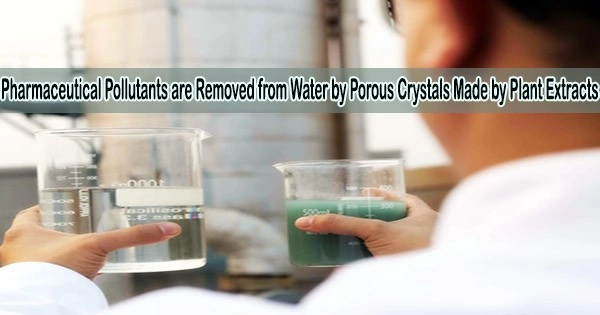Stockholm University researchers to absorb and breakdown pharmaceutical compounds created pomegranate extract-based porous crystals prevalent in regional municipal wastewater. The research is published in the scientific journal Nature Water.
Porous crystals, also known as porous coordination polymers (PCPs), metal-organic frameworks (MOFs), or porous coordination networks (PCNs), are a class of materials that exhibit a unique and well-defined three-dimensional structure with nanoscale-sized pores. These pores create a high surface area and offer the potential for various applications due to their exceptional adsorption, separation, catalytic, and storage properties.
Pharmaceutical substances influence the human body to enhance our health, yet they can also unintentionally have detrimental impacts on wildlife welfare. As a result, new materials and technologies are needed for wastewater treatment plants to remove emerging organic contaminants (EOCs) such active pharmaceutical components.
Utilizing sponge-like porous materials is one method of cleaning water of contaminants. Metal ions and organic molecules combine to form metal-organic frameworks (MOFs), a class of nanoporous material. Synthetic organic compounds are used to create the majority of MOFs.
This has been a very exciting project as we got the opportunity to work directly with water samples from the treatment plant, thereby finding an application where our material could be put to use towards a very pressing environmental issue. We hope one day that SU-102 will be used on a bigger scale and also for other environmental applications.
Erik Svensson Grape
But now, using ellagic acid, a naturally occurring chemical found in plants, researchers from the Department of Materials and Environmental Chemistry at Stockholm University have succeeded in creating novel porous MOFs.
“Ellagic acid is one of the main building units of naturally occurring polyphenols known as tannins, which are common in fruits, berries, nuts, and tree bark. By combining ellagic acid, which was extracted from either pomegranate peel or tree bark, with zirconium ions, we developed a new highly porous MOF which we named SU-102,” says Erik Svensson Grape, PhD student at the Department of Materials and Environmental Chemistry.
Porous crystals are typically composed of metal ions or clusters connected by organic ligands. The combination of metal nodes and organic ligands results in a highly ordered and porous structure. The specific arrangement of metal nodes and ligands can be tailored to achieve desired properties, such as pore size, surface area, and functionality.
In order to test the performance of SU-102, water that had already been purified at a local wastewater treatment facility was further treated with the new MOF. According to the findings, SU-102 effectively eliminated several pharmaceutical contaminants that the wastewater treatment plant was unable to completely remove.
SU-102 was utilized to capture pharmaceutical pollutants as well as to degrade pollutants through a process known as photodegradation.
“This has been a very exciting project as we got the opportunity to work directly with water samples from the treatment plant, thereby finding an application where our material could be put to use towards a very pressing environmental issue. We hope one day that SU-102 will be used on a bigger scale and also for other environmental applications,” says Erik Svensson Grape at Stockholm University.
















